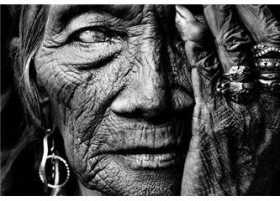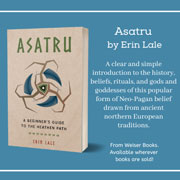The collective energy generated by any given religion should theoretically be fairly well balanced between masculine and feminine energy, but it can go off kilter if there is a serious gender imbalance in both the membership and the amount of worship given to gods, goddesses, and non-gendered beings. During the modern revival of heathenry, heathenry in general and Asatru in particular has attracted more men than women, and it hasn't always been a welcoming place for people who don't fit into modern culture's gender binary, although things have been getting better. The Troth's recent Loki Blot was a huge step forward in growing leadership by non-binary people and in providing space for LGBTQ+ voices.
There's still more work to do, though. Big organizations like the Troth have their own processes to move forward, but individuals can do things too, both in public work and private work. By public work I mean things like providing information on the net. By private work I mean things like doing small rituals at home. Here are a few ideas about things you can do to help out.
Public Work
One of the things I have tried to do with my forum, the Asatru Facebook Forum, is make a safe, welcoming space for women and QUILTBAG folks. Getting rid of trolls and providing space for people to talk about their personal religious experiences and gnosis benefits everyone of all genders and gender expressions, but since in some online communities women and LGBT+ people have been targeted, it is especially important for them to have a safe place to express themselves. I encourage other forum owners and moderators to do the same.
If you're already participating in the Heathen Visibility Project, you can try to include more images of women, goddesses, and objects associated with them. Masculine and feminine are not the only energies, nor the only traditional roles in heathenry, so we can also include more traditional rituals and activities that include or highlight drag or ritual transvetism for religious or magical purposes, heathens engaging in activities that defy conventional gender roles or which show how traditional heathen gender roles differ from modern ones in the wider society in which we live, and people who are nonbinary, transgender, gender fluid, etc., especially when presented in strong roles and positions. Even just moving someone closer to the middle of a group photo rather than on the edge can psychologically make a difference to the viewer. For more info on the Heathen Visibility Project, read the text of my speech on the Project at Las Vegas Pagan Pride Day 2019 here: https://witchesandpagans.com/pagan-paths-blogs/gnosis-diary/speech-on-heathen-visibility-project-ppd-2019.html
A relatively easy thing to do which will have a tremendous impact is raising the profile of women and trans, nb, and gender fluid leaders, authors, musicians, artists, temple keepers, festival organizers, etc. to match the status and fame of men of similar achievements. Search engines and internal site search algorithms for sites like Amazon give prominence to products like books and art that have a lot of reviews and ratings. If you've read an book on Asatru or another relevant product, review it! It makes a huge difference.
Wikipedia is one of the first places people look for information about just about everything. To take a non-random example, I don't have a Wikipedia page, despite being the author of a famous book that is traditionally published (Asatru: A Beginner's Guide to the Heathen Path, an updated version of my out of print book Asatru For Beginners.) There need to be more Asatru authors on the site in general. If you go to Wikipedia and put in "Asatru authors" the list is only one page long and an unfortunately large number of the returns are of white supremacists such as David Lane. You can help fix this right now by going to this link and requesting an Erin Lale page and a page for other notable Asatruars: https://en.wikipedia.org/wiki/Wikipedia:Articles_for_creation
Articles on Asatru and heathenry both by heathen and pagan reporters in pagan venues and by non-heathen and non-pagan reporters in general interest publications tend to quote multiple men and ignore other voices. If you are a reporter, try to be conscious about balancing your interview subjects with regards to gender. If you are contacted by a reporter about Asatru, and you want to refer them to several Asatruars and other heathens, try to refer them to women and T/NB/GF people as well as men.
The same goes for assembling panels on heathenry at conventions, and inviting presenters, ritual leaders, and panelist for pagan festivals. When organizing a festival, convention, or other gathering in which there will be various presenters and leaders, try for a gender balance of the presenters and leaders, and consider LGBTQ+ presenters even if they are less famous than your other presenters.
When participating in sumbel or other rituals in which participants are allowed to choose whom to honor, try to include the goddesses as well as the gods. When designing a ritual, shrine, gathering, etc., try to achieve a balance between gods, goddesses, and other beings of various genders or of no gender.
Private Work
I have a small shrine dedicated to Embla and to the female ancestors generally, especially those who have become powerful spirits connected with their descendants, which we in Asatru call the Disir. I always have some food or drink on it for them. It's a corner of the top of the hutch of my writing desk. I encourage other heathens to honor them as well, in whichever way seems best to them. Asatru has an official holiday for the Disir called Disirblot. Whether on a holiday, in home shrine keeping, toasting during a general gatherings, or in some other way, remember the female ancestors.
If you have a personal practice that includes lots of gods but not many goddesses, or lots of masculine powers but fewer powers who are feminine, non-gendered, gender fluid, etc., consider adding some of those to your personal altars etc. and communicating with them more. If you don't know any of the feminine or nonbinary powers as well as you know the masculine ones, considering learning more about one or more of them. There's a handy list of the gods and goddesses and another handy list of the other powers in my book. Or if reading names on a list doesn't work for you to find one that strikes your fancy, try looking at either classical or contemporary heathen art or reading contemporary poetry in a pagan magazine, and see if you are intrigued by anyone new.





















